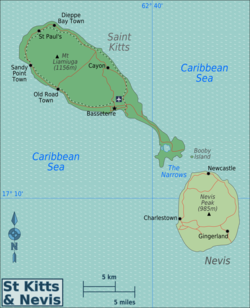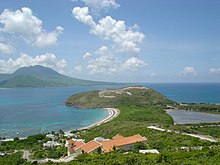
Back Nefis ANG نيفيس Arabic Невіс Byelorussian Невис Bulgarian Nevis Breton Nevis Catalan Nevis (pulo) CEB Nevis Czech Nevis Danish Nevis German
Nevis Queen of the Caribees | |
|---|---|
 Location of Nevis in Saint Kitts and Nevis and among the Leeward Islands. | |
| Capital and largest city | Charlestown 17°20′N 62°45′W / 17.333°N 62.750°W |
| Official languages | English |
| Demonym(s) | Nevisian |
| Government | Parliamentary democracy under a federal constitutional monarchy |
• Monarch | Charles III |
• Deputy Governor-General[1] | Hyleta Liburd |
• Premier | Mark Brantley |
| Farrel Smithen | |
| Legislature | Nevis Island Assembly |
| Area | |
• Total | 93 km2 (36 sq mi) (207th) |
| Population | |
• 2011 census | 12,277[2] |
• Density | 130/km2 (336.7/sq mi) (not ranked) |
| GDP (PPP) | 2009 estimate |
• Total | $726 million[3] |
• Per capita | $13,429[3] |
| GDP (nominal) | 2009 estimate |
• Total | $557 million[3] |
• Per capita | $10,315[3] |
| HDI (2007) | very high (54th) |
| Currency | Eastern Caribbean dollar ($) (XCD) |
| Time zone | UTC−4 (−4) |
| Date format | dd-mm-yyyy (CE) |
| Driving side | left |
| Calling code | +1 869 |
| Internet TLD | .kn |





Nevis (/ˈniːvɪs/ NEE-viss) is an island in the Caribbean Sea that forms part of the inner arc of the Leeward Islands chain of the West Indies. Nevis and the neighbouring island of Saint Kitts constitute the Federation of Saint Kitts and Nevis, a singular nation state. Nevis is located near the northern end of the Lesser Antilles archipelago about 350 kilometres (220 mi) east-southeast of Puerto Rico and 80 kilometres (50 mi) west of Antigua. Its area is 93 square kilometres (36 sq mi) and the capital is Charlestown.[4]
Saint Kitts and Nevis are separated by The Narrows, a shallow 3-kilometre (2 mi) channel. Nevis is roughly conical in shape with a volcano, Nevis Peak, at its centre. The island is fringed on its western and northern coastlines by sandy beaches composed of a mixture of white coral sand with brown and black sand eroded and washed down from the volcanic rocks that make up the island. The gently-sloping coastal plain (1 km (0.62 mi) wide) has natural freshwater springs as well as non-potable volcanic hot springs, especially along the western coast.[citation needed]
The island was named Oualie, translated as "land of beautiful waters", by the Kalinago and Dulcina ("Sweet Island") by the early British settlers. The name Nevis is derived from the Spanish phrase Nuestra Señora de las Nieves, which translates as Our Lady of the Snows; the name was given by its Spanish discoverers and first appeared on maps in the 16th century.[5] Nevis is also known by the sobriquet "Queen of the Caribees", which it earned in the 18th century because of its many sugar plantations.[6]
Nevis is both geographically smaller and less populous than Saint Kitts. It maintains significant autonomy within the federation, including a separate government headed by the premier of Nevis and a separate legislature. Nevis has twice voted – in 1977 and 1998 – to secede from the federation, but neither attempt succeeded.[7]
The majority of the approximately 12,000 Nevisians are of primarily African descent, with notable British, Portuguese, and Lebanese minority communities. English is the official language,[8] and its literacy rate of 98 per cent is one of the highest in the Western Hemisphere.
- ^ The Deputy Governor-General of Nevis is appointed by the Governor-General of Saint Kitts and Nevis, to assent or withhold assent to any bill passed by the Nevis Island Assembly and to perform other functions of the office of Governor-General on His Majesty's behalf relating to Nevis, as the Governor-General may specify. See Chapter III, Sections 23 of the Constitution.
- ^ "St. Kitts and Nevis: Islands, Parishes & Major Towns – Population Statistics in Maps and Charts". citypopulation.de.
- ^ a b c d "Saint Kitts and Nevis". International Monetary Fund. Retrieved 21 April 2010.
- ^ "Saint Kitts and Nevis | Culture, History, & People | Britannica". www.britannica.com. 19 January 2024. Retrieved 16 March 2024.
- ^ Hubbard, Vincent K. (2002). Swords, Ships & Sugar: History of Nevis. Corvallis, Oregon: Premiere, ISBN 1-891519-05-0, pp. 20–23 (Captain Gilbert, Captain Smith), 25 (pearl diving), 41–44 (name Dulcina, treaty with Spain, first settlement), 69–70 (privateers, Captain Francis), 79–85 (slave trade, Royal African Company, Queen of the Caribees), 86–102 (Caribs), 113–120 (d'Iberville, buccaneers), 138–139 (Great Britain's wealth derived from West Indian sugar and slave trade, 1776 starvation), 194–195 (Alexandra Hospital), 211–223 (electricity, Anguilla in 1967, OECD blacklist).
- ^ "Nevis Travel Guide". Travel Vogue. Retrieved 16 March 2024.
- ^ Corbett, Jack (9 May 2023), "Sovereignty", Statehood à la Carte in the Caribbean and the Pacific (1 ed.), Oxford University PressOxford, pp. 35–78, doi:10.1093/oso/9780192864246.003.0002, ISBN 978-0-19-286424-6, retrieved 16 March 2024
- ^ "Saint Kitts and Nevis". The World Factbook. Central Intelligence Agency. Retrieved 5 February 2016.
© MMXXIII Rich X Search. We shall prevail. All rights reserved. Rich X Search

